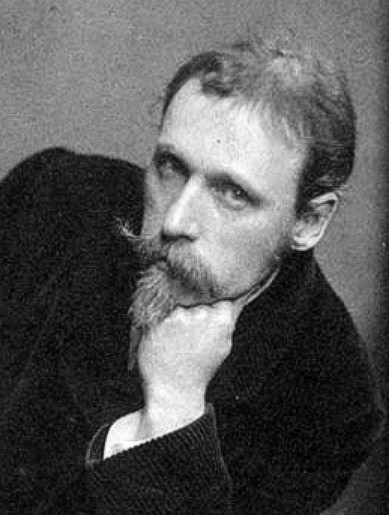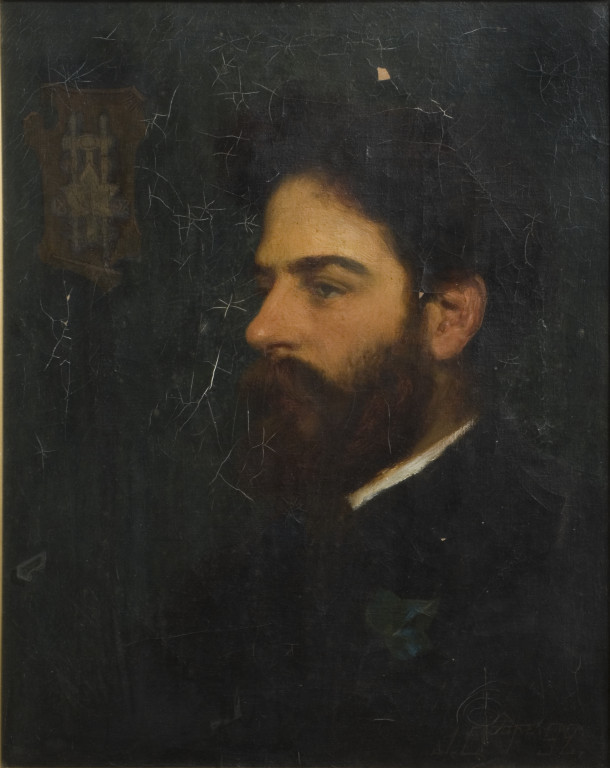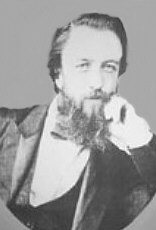<Back to Index>
- Illustrator Walter Crane, 1845
- Artist Nelson Ethelred Dawson, 1859
- Designer Christopher Dresser, 1834
PAGE SPONSOR

Walter Crane (1845 – 1915) was an English artist and book illustrator. He is considered to be the most prolific and influential children’s book creator of his generation and, along with Randolph Caldecott and Kate Greenaway, one of the strongest contributors to the child's nursery motif that the genre of English children's illustrated literature would exhibit in its developmental stages in the latter 19th century. His work featured some of the more colorful and detailed beginnings of the child - in - the - garden motifs that would characterize many nursery rhymes and children's stories for decades to come. He was part of the Arts and Crafts movement and produced an array of paintings, illustrations, children's books, ceramic tiles and other decorative arts.
Walter Crane was born in Liverpool, England, on 15 August 1845, the second son of Thomas Crane, a portrait painter and miniaturist. He was a fluent follower of the newer art movements and he came to study and appreciate the detailed senses of the Pre - Raphaelite Brotherhood, and was also a diligent student of the renowned artist and critic John Ruskin. A set of colored page designs to illustrate Tennyson's "Lady of Shalott" gained the approval of wood engraver William James Linton to whom Walter Crane was apprenticed for three years (1859 – 1862). As a wood engraver he had abundant opportunity for the minute study of the contemporary artists whose work passed through his hands, of Pre - Raphaelites Dante Gabriel Rossetti and John Everett Millais, as well as Alice in Wonderland illustrator Sir John Tenniel and Frederick Sandys. He was a student who admired the masters of the Italian Renaissance, however he was more influenced by the Elgin marbles in the British Museum. A further and important element in the development of his talent was the study of Japanese color prints, the methods of which he imitated in a series of toy books, which started a new fashion.
From the early 1880s, initially under Morris's influence, Crane was closely associated with the Socialist movement. He did as much as Morris himself to bring art into the daily life of all classes. With this object in view he devoted much attention to designs for textiles and wallpapers, and to house decoration; but he also used his art for the direct advancement of the Socialist cause. For a long time he provided the weekly cartoons for the Socialist organs Justice, The Commonweal and The Clarion. Many of these were collected as Cartoons for the Cause. He devoted much time and energy to the work of the Art Workers Guild, and to the Arts and Crafts Exhibition Society, founded by him in 1888. He was also a Vice President of the Healthy and Artistic Dress Union, a movement begun in 1890, whose aim was to promote the loose fitting clothing, in opposition to "stiffness, tightness and weight". They produced numerous pamphlets setting out their cause, including one entitled 'How to Dress Without a Corset' which Crane illustrated.
Although not himself an anarchist, Crane contributed to several libertarian publishers, including Liberty Press and Freedom Press. Following the Haymarket bombing, Crane made multiple trips to America where he spoke in defense of the eight anarchists accused of murder.
Walter Crane died on 14 March 1915 in Horsham Hospital, West Sussex. His body was cremated at the Golders Green Crematorium, where his ashes remain. He was survived by three children, Beatrice, Lionel and Lancelot.
In 1862 his picture "The Lady of Shalott" was exhibited at the Royal Academy, but the Academy steadily refused his maturer work and after the opening of the Grosvenor Gallery in 1877, he ceased to send pictures to Burlington House. In 1863 the printer Edmund Evans employed Crane to illustrate yellowbacks, and in 1865 they began to collaborate on toy books of nursery rhymes and fairy tales. From 1865 to 1876 Crane and Evans produced two to three toy books each year.
In 1864 he began to illustrate a series of sixpenny toy books of nursery rhymes in three colors for Edmund Evans. He was allowed more freedom in a series beginning with The Frog Prince (1874) which showed markedly the influence of Japanese art, and of a long visit to Italy following on his marriage in 1871. His work was characterized by sharp outlines and flat tints. The Baby's Opera was a book of English nursery songs planned in 1877 with Evans, and a third series of children's books with the collective title Romance of the Three R's provided a regular course of instruction in art for the nursery. In his early "Lady of Shalott", the artist had shown his preoccupation with unity of design in book illustration by printing in the words of the poem himself, in the view that this union of the calligrapher's and the decorator's art was one secret of the beauty of the old illuminated books.
He followed the same course in The First of May: A Fairy Masque by his friend John Wise, text and decoration being in this case reproduced by photogravure. The Goose Girl illustration taken from his beautiful Household Stories from Grimm (1882) was reproduced in tapestry by William Morris. Flora's Feast, A Masque of Flowers had lithographic reproductions of Crane's line drawings washed in with water color; he also decorated in color The Wonder Book of Nathaniel Hawthorne, and Margaret Deland's Old Garden. In 1894 he collaborated with William Morris in the page decoration of The Story of the Glittering Plain, published at the Kelmscott Press, which was executed in the style of 16th century Italian and German woodcuts. Crane illustrated editions of Edmund Spenser's Faerie Queene (19 pts., 1894 – 1896) and The Shepheard's Calendar, as well as Ali Baba and the Forty Thieves (1873), The Happy Prince and Other Stories by Oscar Wilde (1888), an edition of Arthurian Legends, and A Flower Wedding.
Crane wrote and illustrated three books of poetry, Queen Summer (1891), Renascence (1891) and The Sirens Three (1886). Walter Crane illustrated Nellie Dale's books on Teaching English Reading: Steps to Reading, First Primer, Second Primer, Infant Reader, Book I and Book II. These were most probably completed between 1898 and 1907.
His own easel pictures, chiefly allegorical in subject, among them "The Bridge of Life" (1884) and "The Mower" (1891), were exhibited regularly at the Grosvenor Gallery and later at the New Gallery. "Neptune's Horses" was exhibited at the New Gallery in 1893, and with it may be classed his "Rainbow and the Wave."
His varied work includes examples of plaster relief, tiles, stained glass, pottery, wallpaper and textile designs, in all of which he applied the principle that in purely decorative design "the artist works freest and best without direct reference to nature, and should have learned the forms he makes use of by heart." An exhibition of his work of different kinds was held at the Fine Art Society's galleries in Bond Street in 1891, and taken to the United States in the same year by the artist himself. It was afterwards exhibited in Germany, Austria and Scandinavia.
Crane was elected a member of the Institute of Painters in Water Colours in 1882, resigning in 1886; two years later he became an associate of the Water Colour Society (1888); he was an examiner for the Science and Art Department at the South Kensington Museum (now the Victoria & Albert Museum; director of design at the Manchester Municipal School (1894); art director of Reading College (1896); and in 1898 for a short time principal of the Royal College of Art. His lectures at Manchester were published with illustrated drawings as The Bases of Design (1898) and Line and Form (1900). The Decorative Illustration of Books, Old and New (2nd ed., London and New York, 1900) is a further contribution to theory. A well known portrait of Crane by George Frederick Watts was exhibited at the New Gallery in 1893.
One of his last major works would be his lunettes at the Royal West of England Academy which were painted in 1913.

Nelson Ethelred Dawson (1859 – 1941) was an English artist and member of the Arts and Crafts movement.
Dawson was born in Stamford, Lincolnshire, and educated at Stamford School. He moved to London, where he operated his workshop first from Chelsea and in due course from the rear of his townhouse in Chiswick. He exhibited his art throughout England including at the Royal Academy and was elected an Associate of the Royal Society of Painters in Water Colours and a Fellow of the Royal Society of Engravers.
As a potter, watercolor painter, jeweler, silversmith, metalworker, etcher, print maker and writer on artistic subjects, his reputation has probably suffered because he spread his talents too thinly. Nevertheless, both the British Museum and the Victoria & Albert Museum hold collections of his work and papers. He married Edith Robinson in 1893 and together with his wife, he was one of the key figures in the jewellery of the Arts and Crafts movement.
Edith learned enameling from her husband who had been taught by Alexander Fisher, a master enameler who in turn had learned his craft in France. Together, they revived the Renaissance practice of enameling in their jewellery.
The bronze organ grill in Holy Trinity church, Sloane Street, Chelsea (described by Poet Laureate, John Betjeman as the "Cathedral of the Arts & Crafts Movement") is Dawson’s work and it takes its place beside treasures by William Morris and Edward Burne - Jones. Other commissions included a trowel and mallet and trowel used by Queen Victoria in her last public appearance, laying the foundation stone of the Victoria & Albert Museum in 1899, the casket presented to U.S. President Woodrow Wilson on his visit to England en route to the Paris Peace Conference, 1919, lavish bath fittings for Viscount Hambleden in copper and silver, and the gates of Hull Guildhall.
In 1901, Dawson founded The Artificers' Guild from his workshop in Chiswick but it was acquired by Montague Fordham (one time director of the Birmingham Guild and School of Handicrafts) in 1903.
He is noted for his maritime scenes.
Dawson left many of his pictures to Stamford School but although a number of etchings and watercolors still decorate the walls of the school, not all were stored or displayed properly and some canvasses were even painted over by pupils.
A retrospective of his work at Stamford Museum closed on 26 January 2008. Georgetown University Library in 2009 hosted an exhibition of his marine views called Etched by the Sea.

Christopher Dresser (Glasgow, 4 July 1834 – Mulhouse, 24 November 1904) was a Scottish designer and design theorist, now widely known as one of the first and most important, independent, designers and was a pivotal figure in the Aesthetic Movement, and a major contributor to the allied Anglo - Japanese branch of the Movement; both originated in England and had long lasting international influence.
Dresser was born in Glasgow, Scotland. At age 13, he began attending the Government School of Design, Somerset House. He received training in design and took botany as his specialization. He lectured on the new subject of Art Botany to complete his studies before his appointment in 1855 as Professor of Artistic Botany in the Department of Science and Art, South Kensington He wrote a series of articles that appeared in the Art Journal in 1857, "Botany as Adapted to the Arts and Art Manufactures." In 1858 he sold his first designs.
He was awarded a doctorate in absentia from the University of Jena, Germany, in 1859 for his writings.
From this early date his design work widened to include carpets, ceramics, furniture, glass, graphics, metalwork, including silver and electroplate, and textiles printed and woven. In 1865 the Building News reported that in the early part of his career he had been active as a designer of wallpapers, textiles and carpets thus the most active revolutionizer in the decorative art of the day. He wrote several books on design and ornament, including The Art of Decorative Design (1862), The Development of Ornamental Art in the International Exhibition (1862) and Principles of Design (1873).
In four months in 1876 - 1877 Dresser traveled about 2000 miles in Japan, recording his impressions in Japan, its Architecture, Art and Art - Manufactures. He represented the South Kensington Museum whilst in Japan, and was received at court by the Emperor, who ordered Dresser to be treated as a guest of the nation – all doors were open to him. He was requested by the Japanese Government to write a report on 'Trade with Europe'. His pioneering study of Japanese art is evident in much of his work which is considered typical of the Anglo - Japanese style.
Between 1879 and 1882, as Art Superintendent at the Linthorpe Art Pottery in Linthorpe in Middlesbrough he designed over 1,000 pots. If his ceramic work from the 1860s onward (for firms such as Mintons, Wedgwood, Royal Worcester, Watcombe, Linthorpe, Old Hall at Hanley and Ault) is considered, he must be among the most influential ceramic designers of any period. Much of his work remains to be identified, although wallpaper designs for American, and textiles for French and German manufacturers have recently been located.
Some of Dresser’s metalwork designs are still in production, such as his oil and vinegar sets and toast rack designs, now manufactured by Alessi and Alberto Alessi goes so far as to say Dresser 'knew the techniques of metal production better than any designer who has come to Alessi'.
One of his Old Hall designs is thought to have inspired Alan Garner's 1967 novel The Owl Service.